
Homosexuality in China was traditionally widespread in the region. Historically; homosexual relationships were regarded as a normal facet of life; and the existence of homosexuality in China has been well documented since ancient times. Many early Chinese emperors are speculated to have had homosexual relationships; often accompanied by heterosexual ones. Opposition to homosexuality and the rise of homophobia did not become firmly established in China until the 19th and 20th centuries; through the Westernization efforts of the late Qing Dynasty and early Republic of China. Homosexuality was banned in the People's Republic of China; until it was legalised in 1997.
Traditional terms for homosexuality included 'the passion of the cut sleeve' (????; Mandarin; Pinyin: du鄋xi?zhi pi); and 'the bitten peach' (?? Pinyin: fent醥). Other; less literary; terms have included 'male trend' (?? Pinyin: n醤feng); 'allied brothers' (???? Pinyin: xianghuo xiongd?; and 'the passion of Longyang' (??? Pinyin: l髇gy醤gpi); referencing a homoerotic anecdote about Lord Long Yang in the Warring States Period. The formal modern word for homosexuality/homosexual is tongxinglian (???; Pinyin: t髇gx靚gli鄋; literally same-sex relations/love) or tongxinglian zhe (????; Pinyin: t髇gx靚gli鄋 zhe; homosexual people). Instead of this formal word; 'tongzhi' (?? Pinyin: t髇gzh?; simply a head-rhyme word; is more commonly used in the gay community.
| px | px | dpi | = | cm | x | cm | = | MB |
Details
Creative#:
TOP20146469
Source:
達志影像
Authorization Type:
RM
Release Information:
須由TPG 完整授權
Model Release:
No
Property Release:
No
Right to Privacy:
No
Same folder images:

 Loading
Loading